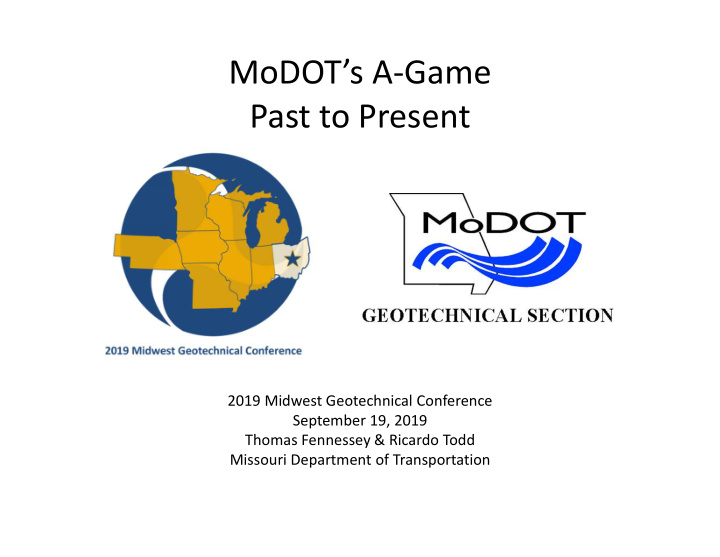



MoDOT’s A-Game Past to Present 2019 Midwest Geotechnical Conference September 19, 2019 Thomas Fennessey & Ricardo Todd Missouri Department of Transportation
MoDOT Use of Resistivity Began in 1930 “Purpose – The purpose of this paper is to report past experience in Missouri with resistivity testing by use of a Megger instrument and to present the results of recent tests using Gish-Rooney resistivity equipment.” “History – The Missouri State Highway Department was one of the first highway organizations to use resistivity methods for classifying excavation materials. Since 1930 the same Megger instrument has been used intermittently throughout the state for resistivity testing.” From paper presented at the 1958 AASHO Meeting, San Francisco, CA
Megger Resistivity Instrument - 1930’s
Resistivity Apparatus - 1940 “Field set-up for measuring natural earth potentials: a. potentiometer, b. nonpolarizing electrode at base station, c. non polarizing electrode being set at field station, d. reel carrying connecting wire. (After Jakosky, 1940, p. 259.)” http://www.kgs.ku.edu/Publications/Bulletins/44/05_geop.html
Gish-Rooney Resistivity System - 1958 https://pubs.er.usgs.gov/publication/ofr5899 Gish-Rooney Instrument
MoDOT’s Resistivity System - 1958 GEOMETER GISH-ROONEY TYPE MOD. 9 SER. NO. 321 PAT. NO. 1,813,845 2,274,903 GEOPHYSICAL INSTRUMENT CO DIVISION OF GEORATOR CORP. MANASSAS, VA U.S.A.
MoDOT’s First Use of Seismic - 1959 Work for this report was part of “a comparison of soundings made at the same locations by means of power augers, seismic refraction, and electrical resistivity”.
Bureau of Public Roads Resistivity Apparatus “Earth-resistivity apparatus of the type shown in Figure 10 can be purchased for about $800 and can be built for less in instances where the prospective buyer wishes to construct his own apparatus. The commutator-equipped apparatus usually has sold for about twice as much as the simpler apparatus.” From Geophysical Method of Subsurface Exploration Applied to Materials Surveys, R. Woodward Moore, Highway Engineer, Bureau of Public Roads, 1962 http://onlinepubs.trb.org/Onlinepubs/hrbbulletin/62/62-003.pdf
Bureau of Public Roads Seismic Refraction Apparatus “Seismic equipment of the type shown in Figure 2 has been available in the past at a cost of $4,000 to $5,000.” “Small charges of dynamite, ranging from about 1/8 lb. to 1 or 2 lb., buried 3 or 4 ft. beneath the surface, are then fired at various distances from the group of detectors, on the detector line extended, and the time of wave travel from the shot point to each detector is recorded.” From Geophysical Method of Subsurface Exploration Applied to Materials Surveys, R. Woodward Moore, Highway Engineer, Bureau of Public Roads, 1962 http://onlinepubs.trb.org/Onlinepubs/hrbbulletin/62/62-003.pdf
DOT’s with Geophysical Equipment - 1970
Geophysical Information - Seismic
Geophysical Information - Resistivity
MoDOT’s Seismic System (1970’s) Bison Instrument Seismograph Model 1570B & Blaster Model 1430 Purchased for $4400 in 1975
MoDOT’s Seismic System (1970’s)
Seismic Refraction Data Sheet
Seismic Refraction Data Sheet
Rippability Determination from Seismic Velocity
MoDOT’s Resistivity System (1980’s) Bison Instrument Earth Resistivity Meter Model 2350B Purchased for $3000 in 1987
Resistivity Data Sheet
MoDOT’s GPR System “ In 2005, the MoDOT Historic Preservation section purchased a GPR survey system—manufactured by Geophysical Survey Systems, Inc. (GSSI)—consisting of a SIR- 3000 control unit, survey wheel, and a 270 MHz low-frequency antenna (Model 5104).”
2007 Slide Investigation GPR & Auger Borings
Groundtruth Comparison
MoDOT’s Current Resistivity System Electrical Resistivity System (battery powered) purchased 10/17 for $59300 (without batteries) Generator and power supplies (operate without batteries) purchased 12/18 for $4000
Original Quote – October 2016 Name Price Quantity Subtotal SuperSting R4/IP/SP Wi-Fi Resistivity/IP/SP meter $23,608 1 $23,608 Heavy duty carry case for SuperSting $500 1 $500 SwitchBox R8 with 56 electrodes capability $132700 1 $13270 Heavy duty carry case for SwitchBox $300 1 $300 Passive land cable 14x5.25x3.5 for 28eSB $2207 4 $8828 Medium Electrode Cable Box $595 2 $1190 Stainless steel electrode, 457 mm x 9.5 mm $60 44 $2640 Electrode Stake Box (fits 56) $450 1 $450 Electrode Warning cover $32 56 $1792 EarthImager 2D Software $3650 1 $3650 Resistivity Imaging Seminar $0 1 $0 EarthImager 2D upgrade to EarthImager 2D & 3D $3520 1 $3520 Total $59748
Foundation Inv. – Cape Girardeau County 55 & US 61 – 6/18
Sinkhole Inv. – Greene County MO 160 & FR115 – 10/18
Foundation-Roadway Inv. – Greene County US 60 & MO 125 – 11-12/18 A special foundation investigation has been performed for the above referenced project which is located at the intersection of US 60 and MO 125 at Rogersville, Missouri, in Greene County. It is understood that this project is being undertaken to replace the existing at- grade intersection with a grade-separation intersection at the same location. This improvement is to include construction of a new bridge and MSE walls to carry US 60 over MO 125. Additionally, this improvement is to include construction of adjacent intersection ramps and several outer roadways to provide property access to impacted property owners. For this project, district personnel requested that electrical resistance imaging (ERI) be performed adjacent to the existing alignment of US 60 intersection and along several proposed outer roadway options to identify resistivity anomalies associated with potential karst features that might impact project features. As a result, a total of 18 ERI lines with a total linear length of over 10,800 feet were performed for this special foundation investigation, as shown and identified on Figure 1. Details regarding the investigation and results for each ERI line performed are presented in the following paragraphs.
Portion of Greene County Sinkhole Map
Current Plan
Detention Basin Inv. – Christian County MO 14 – 4/19
Recommend
More recommend